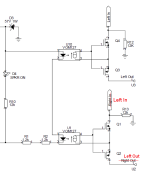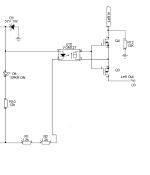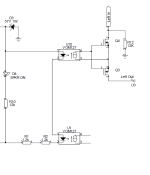For the new Nad design replacement board it seems to be able to work for positive offset , not for negative, unless there is some others circuit which is on the board and since amp service manual i can’t find where this new design was given, not sure how this would work.
Good Price!
Sorry but i will repeat....it is time for the discrete replacement of UPC1237.
A friend of mine can draw a very small pcb but he don't know if the smd version of transistors can handle the power.
Andrew know for sure.
Its a job for a microprocessor. Maybe I can do one, but it will be SMD (20 or 28 pin SOIC) 🙂
EVRERY job is a job for a microprocessor these days (For those that hate coding, sad but true - queue Metallica here).
Somebody will just have to make some cute little PCB kit with SMDs that directly plug in where the old IC did. People are resorting to that to replace STK modules, often making something BETTER than the original - and there are boards for sale IIRC. The UPC1237 replacement might sell more, having a wider market. Pre-assembled for a few bucks more, perhaps.
Somebody will just have to make some cute little PCB kit with SMDs that directly plug in where the old IC did. People are resorting to that to replace STK modules, often making something BETTER than the original - and there are boards for sale IIRC. The UPC1237 replacement might sell more, having a wider market. Pre-assembled for a few bucks more, perhaps.
Do it I will be a testerIts a job for a microprocessor. Maybe I can do one, but it will be SMD (20 or 28 pin SOIC) 🙂
Something like this:-
Protection/Amp Management features
•Amp Output DC offset protection
•Amplifier overcurrent detection
•Amplifier oscillation detection (> 1V pk-pk at >50 kHz)
•Mains in-rush current limiting control
•Speaker enable delay (5 seconds) on power up, fast (<25ms) disable on power down using mosfet solid state relay. Requires access to transformer secondary AC
•Speaker enable/disable using supply voltage detection – can be used with class D amplifiers
•Heatsink overtemperature monitor – trip at 65C and reset at 55C
•Main power ON/OFF relay control if used with standby PSU (~1W at 5V) allowing use of low voltage power switch
•Amplifier clipping indicator
•Tri-colour LED status indication
So all these functions would be on the controller, but you could put it into a circuit and only use the ones you wanted, for example
•Amp Output DC offset protection
•Amplifier overcurrent detection and trip input
•Mains in-rush current limiting control
•Speaker enable delay (5 seconds) on power up, fast (<35ms) disable on power down using mosfet solid state relay. Requires access to transformer secondary AC
•Tri-colour LED status indication
To make it fail safe, you trigger a monitor cycle every mains zero crossing (10ms for 50 Hz, 8.33ms for 60 Hz) an arrange it so the controller resets if trigger doesn't come within say 2 ms of when it should.
The expense in these uController approaches is usually in the additional cost of the power supply and ancillary components around the controller. Nevertheless, I'm surprised NAD aren't going down this route since they already have a controller to do the remote and you can always prioritise the amp protection over everything else.
Protection/Amp Management features
•Amp Output DC offset protection
•Amplifier overcurrent detection
•Amplifier oscillation detection (> 1V pk-pk at >50 kHz)
•Mains in-rush current limiting control
•Speaker enable delay (5 seconds) on power up, fast (<25ms) disable on power down using mosfet solid state relay. Requires access to transformer secondary AC
•Speaker enable/disable using supply voltage detection – can be used with class D amplifiers
•Heatsink overtemperature monitor – trip at 65C and reset at 55C
•Main power ON/OFF relay control if used with standby PSU (~1W at 5V) allowing use of low voltage power switch
•Amplifier clipping indicator
•Tri-colour LED status indication
So all these functions would be on the controller, but you could put it into a circuit and only use the ones you wanted, for example
•Amp Output DC offset protection
•Amplifier overcurrent detection and trip input
•Mains in-rush current limiting control
•Speaker enable delay (5 seconds) on power up, fast (<35ms) disable on power down using mosfet solid state relay. Requires access to transformer secondary AC
•Tri-colour LED status indication
To make it fail safe, you trigger a monitor cycle every mains zero crossing (10ms for 50 Hz, 8.33ms for 60 Hz) an arrange it so the controller resets if trigger doesn't come within say 2 ms of when it should.
The expense in these uController approaches is usually in the additional cost of the power supply and ancillary components around the controller. Nevertheless, I'm surprised NAD aren't going down this route since they already have a controller to do the remote and you can always prioritise the amp protection over everything else.
I have done something like this here.https://www.diyaudio.com/community/threads/no-global-loop-amplification.312866/post-6401437
Jeff sent me this excellent pcb and parts.
Jeff sent me this excellent pcb and parts.
Last edited:
I have seen Pioneer monitor the AMP supply and Regulated supplies for a error to turn the amp off. but not so in Base level Yamaha like 202Something like this:-
Protection/Amp Management features
•Amp Output DC offset protection
•Amplifier overcurrent detection
•Amplifier oscillation detection (> 1V pk-pk at >50 kHz)
•Mains in-rush current limiting control
•Speaker enable delay (5 seconds) on power up, fast (<25ms) disable on power down using mosfet solid state relay. Requires access to transformer secondary AC
•Speaker enable/disable using supply voltage detection – can be used with class D amplifiers
•Heatsink overtemperature monitor – trip at 65C and reset at 55C
•Main power ON/OFF relay control if used with standby PSU (~1W at 5V) allowing use of low voltage power switch
•Amplifier clipping indicator
•Tri-colour LED status indication
So all these functions would be on the controller, but you could put it into a circuit and only use the ones you wanted, for example
•Amp Output DC offset protection
•Amplifier overcurrent detection and trip input
•Mains in-rush current limiting control
•Speaker enable delay (5 seconds) on power up, fast (<35ms) disable on power down using mosfet solid state relay. Requires access to transformer secondary AC
•Tri-colour LED status indication
To make it fail safe, you trigger a monitor cycle every mains zero crossing (10ms for 50 Hz, 8.33ms for 60 Hz) an arrange it so the controller resets if trigger doesn't come within say 2 ms of when it should.
The expense in these uController approaches is usually in the additional cost of the power supply and ancillary components around the controller. Nevertheless, I'm surprised NAD aren't going down this route since they already have a controller to do the remote and you can always prioritise the amp protection over everything else.
Hello BonsaiI've designed a simple speaker protection board using the UPC1237 (Unisonic Taiwan is the manufacturer, originally uPC1237 from NEC) that uses mosfets rather than a relay to switch the speaker. The circuit operates from 25V to 75V with some resistor changes (detailed in the write-up), features power up/down muting, DC offset protection and an input to trip the protection on overcurrent (you will need to arrange your own short circuit detection - the board just takes an input for this as a trigger).
There's a presentation with the circuit, BOM and if you want a board, you can buy one off the website.
Hifisonix Speaker Protection Board
Happy soldering
🙂
The link provided on the top floor has no longer worked~
One of the builders has had a problem with his board in which he could not get the AC detect to work. We even suspected the UPC1237 to be at fault. However, he discovered it worked when he moved the AC detect input to a different secondary winding. I did a quick sim to look at the secondary AC voltages wrt his issue and have identified the problem - I should have seen this earlier, and as a result of his experience will have to add some additional notes to the build instructions.
Here is the test circuit - note the voltages Vac1 through Vac4

Here are the voltages Vac1 through Vac4 wrt 0V

What you can see is that Vac3 and Vac4 are effectively pushed down so they swing from ~0V all the way down to -40 V peaks. So, he was connecting to Vac3 or Vac4 on his build and that's why it did not work.
You can only link to Vac1 or Vac2 in split secondary power supplies like this that first rectify and smooth each rail before combining them otherwise the Speaker Protection Board AC detect won't work. Alternatively, you can wire a 2.2uF film capacitor in series with the AC detect and that will also work on any of the windings, but I think the best solution is to just stick to picking up connections Vac1 or Vac2 as shown here
Apologies to anyone else who had this issue and my thanks to Michael and his girlfriend for solving it! 🙂
For split rail power supplies that use a single bridge rectifier like that shown below you can take the AC detect off either Vac1 or Vac4 :-

Here is the test circuit - note the voltages Vac1 through Vac4
Here are the voltages Vac1 through Vac4 wrt 0V
What you can see is that Vac3 and Vac4 are effectively pushed down so they swing from ~0V all the way down to -40 V peaks. So, he was connecting to Vac3 or Vac4 on his build and that's why it did not work.
You can only link to Vac1 or Vac2 in split secondary power supplies like this that first rectify and smooth each rail before combining them otherwise the Speaker Protection Board AC detect won't work. Alternatively, you can wire a 2.2uF film capacitor in series with the AC detect and that will also work on any of the windings, but I think the best solution is to just stick to picking up connections Vac1 or Vac2 as shown here
Apologies to anyone else who had this issue and my thanks to Michael and his girlfriend for solving it! 🙂
For split rail power supplies that use a single bridge rectifier like that shown below you can take the AC detect off either Vac1 or Vac4 :-
Last edited:
And what if I have separate tap that is a part of my amplifier power supply but not used for amp but only for ac detect would that be ok. This question is because I am going to get a transformer wound
The AC detect input is referenced to 0V. You will not need a separate AC detect winding - if you hook the AC detect up as shown in post #194 above you will be ok.
Actually, placing the two opticouplers in series and using one set of MOSFETS is also an option. That's what I did on my monoblocks. Should trip faster, twice as much voltage.
- Home
- Amplifiers
- Solid State
- Speaker Protection Board



